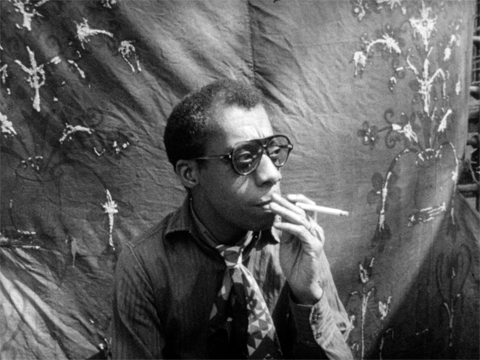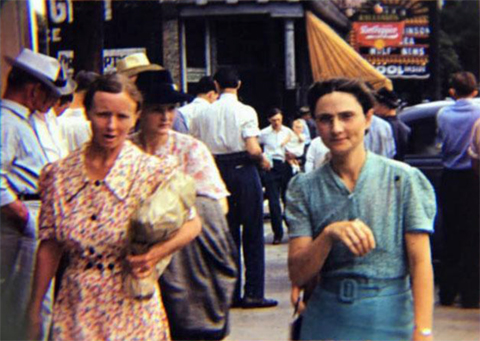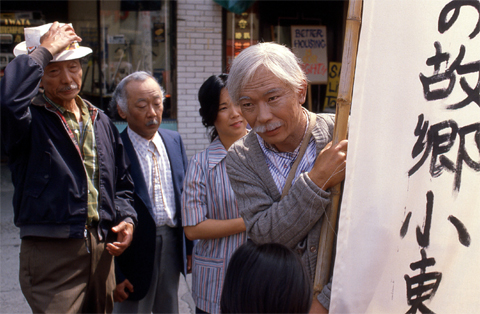- Films Preserved Through the NFPF
- 2014 Federal Grant Winners
- 2015 Federal Grant Winners
- 2016 Federal Grant Winners
- 2017 Federal Grant Winners
- 2018 Federal Grant Winners
- 2019 Federal Grant Winners
- 2020 Federal Grant Winners
- 2021 Federal Grant Winners
- 2022 Federal Grant Winners
- 2023 Federal Grant Winners
- 2024 Federal Grant Winners
- 2025 Federal Grant Winners
2019 Federal Grant Winners
-
Anonymous Artists of America (1969–70), footage of an outdoor concert at the University of Chicago by the eponymous psychedelic rock collective (Kartemquin Films). James Baldwin: From Another Place (1973) will be preserved by the Yale Film Study Center with NFPF support.
James Baldwin: From Another Place (1973) will be preserved by the Yale Film Study Center with NFPF support. - A.R. Cole, Potter (1969), Terry Wayne Rushin’s documentary on Arthur Ray Cole and his daughters at work in the family pottery (University of North Carolina at Chapel Hill).
- Bathroom (1969), Fred Camper’s structural film study of a boarding house restroom (Chicago Film Society).
- Below the Surface (1920), intense melodrama with scenes of underwater peril, directed by Irvin Willat and starring Hobart Bosworth (San Francisco Silent Film Festival).
- Bridgeport, Connecticut in the Blizzard of 1934 (1934), amateur footage of the snowstorm that buried Bridgeport under 28 inches of snow (Bridgeport Public Library).
- Bringin’ Home the Bacon (1924), Western feature directed by Richard Thorpe, starring “Buffalo Bill Jr.” and Jean Arthur (George Eastman Museum).
- The Bus (1965), cinema-verité documentary by Haskell Wexler, following the cross-country journey of several activists to the 1963 March on Washington (UCLA Film & Television Archive).
- Camera on Chicago (1940–83), documentation of Chicago’s changing face and cultural diversity by amateur filmmaker Warren Thompson (Chicago Film Archives).
- Canyons in the Making (ca. 1948–50), instructional film featuring the Grand Canyon by naturalist Paul G. Howes (Bruce Museum).
- Daly Family Collection, Part 2 (1919–21), home movies of leisure activities enjoyed by the founding family of the Anaconda Copper Mining Company at the Daly Mansion (Montana Historical Society).
- Dink: Pre-Blues Musician (1975), scholar Cecelia Conway’s portrait and performance film of African American banjo player Dink Roberts (Folkstreams).
- Doll Messengers of Friendship (1929), documentation of a 1920s doll exchange between the U.S. and Japan, initiated by the Committee on World Friendship Among Children (Chicago Film Society).
- Dzibilchaltún Archaeological Expeditions (1957–60), lecture film by Dr. E. Wyllys Andrews of the NGS–Tulane University expedition that excavated one of the largest Mayan sites on the Yucatán peninsula (National Geographic Society).
- Electricity Comes to the Village (ca. 1971), community-produced film from the Yup’ik village of Emmonak, used to express local concerns to the public utility (Alaska Moving Image Preservation Association).
- Entering the Valley That Time Forgot (1954), footage of the CMA’s first contact with the Dani Tribes of Papua, Indonesia, in 1954 (Christian & Missionary Alliance).
- The Films of Victor Grauer (1965–78), 25 stroboscopic, structural, and minimalist works by the “neo-modernist” filmmaker (Anthology Film Archives).
- The Fitzgeralds in Hollywood (1927), footage of Zelda and F. Scott Fitzgerald, along with actresses Lois Moran and Carmel Myers (Mid-Atlantic Regional Moving Image Archive).
- Flying Farmers (1947–49), documentation of conventions held by the national association of farmers who utilized aircraft, staged as part of OSU’s Farm and Home Week (Oklahoma State University).
- Four Seasons, Part II: Winter (ca. 1950s), nature film by naturalist Paul G. Howes (Bruce Museum).
- France III (1961), Beryl Sokoloff’s experimental portrait of a nation in turmoil (Phoenix Arts Alliance).
- Francis Lee: Eskimo Life on the Yukon Delta (ca. 1970), documentation of a Yup’ik village elder lamenting the loss of native ways (Alaska Moving Image Preservation Association).
- Frank D. Muramoto Collection (ca. 1930s–40s), home movies by the owner of a photography studio in Pueblo, Colorado, documenting family life and the local Japanese American community (Pueblo City-County Library District).
-
Greenville in Reelife (1941), town portrait of Greenville, North Carolina (East Carolina University). Greenville in Reelife (1941) will be preserved by East Carolina University with NFPF support.
Greenville in Reelife (1941) will be preserved by East Carolina University with NFPF support. - Harry Leonard’s Wiseman Films (1930–48), home movies of the small mining community of Wiseman, Alaska, and its multicultural inhabitants (University of Alaska Fairbanks).
- Hito Hata: Raise the Banner (1980), dramatic feature about redevelopment and gentrification in the Little Tokyo neighborhood of Los Angeles, starring Mako, Pat Morita, and Yuki Shimoda (Visual Communications).
- Hum 255 (1970), filmed discussion of political activism led by students expelled after the 1968 strike at the University of Chicago (Kartemquin Films).
- Immigration of Yemenite Jews to Israel (1949), footage taken by the president of Alaska Airlines of the Operation Magic Carpet airlift mission, which transported 49,000 Yemenites (American Jewish Joint Distribution Committee).
- James B. Carey Collection (ca. 1945–48), home movies of travels in Europe and the Soviet Union by the secretary-treasurer of the CIO and future president of the International Union of Electrical Workers (Rutgers University).
- James Baldwin: From Another Place (1973), Sedat Pakay’s documentary of James Baldwin in Istanbul (Yale Film Study Center).
- Jarrell and Cockerham (1971), Blanton Owen’s documentation of old-time music performances by banjoist Fred Cockerham and fiddler Tommy Jarrell (University of North Carolina at Chapel Hill).
- Let the Birds Tell It All (1957–58), naturalist Paul G. Howes’s nature film on life from animals’ point of view (Bruce Museum).
- Listen to a Stranger: An Interview with Gordon Parks (1973), portrait of the photographer/director at home and at work filming Shaft’s Big Score (Washington University in St. Louis).
- Love (1960), exploration of the streets of New York by Beryl Sokoloff (Phoenix Arts Alliance).
- Not Wedded But a Wife (1921), Mutt and Jeff cartoon released by Fox (ASIFA-Hollywood).
- Observing As You Go (1957), naturalist Paul G. Howes’s instructional film (Bruce Museum).
- On the Shores of Lake Michigan (1948), travelogue of the region’s touristic and industrial highlights by Illinois photographer Julian Gromer (Chicago Film Archives).
- Paris Travelogue, April 1948 (1948), footage of the Jewish Distribution Committee’s Paris conference to assess the conditions of Holocaust survivors in Displaced Persons camps (American Jewish Joint Distribution Committee).
- Prewar Peasants of Central Europe (1938), art collector Clara Hoover’s documentation of an intensive folk art workshop spread across Hungary (Museum of International Folk Art).
- The Scientific Expedition to the South Pacific in the Yacht Zaca (1934–35), documentation of the AMNH Templeton Crocker Expedition of 1934–35 by California Academy of Sciences artist Toshio Asaeda (American Museum of Natural History).
- A Sleeping Memory (1917), Metro Pictures melodrama involving brain surgery, hypnosis, and past lives, based on the E. Phillips Oppenheim novel (George Eastman Museum).
- SUMMER 68 (1969), documentary following three activist groups as they prepare to protest the 1968 Democratic National Convention in Chicago (Third World Newsreel).
- Tellin’ the World (1972), public service announcement made to encourage working-class and minority youth voting after the passage of the 26th amendment (Wisconsin Center for Film and Theater Research).
-
Travel Films of George L.K. Morris (1934), home movies of the abstract painter’s travels through Indonesia, Myanmar, and Thailand (Frelinghuysen Morris House & Studio). Hito Hata: Raise the Banner (1980) will be preserved by Visual Communications with NFPF support.
Hito Hata: Raise the Banner (1980) will be preserved by Visual Communications with NFPF support. - Travers (1961), abstract study of light and pattern and of nature and artifice by Beryl Sokoloff (Phoenix Arts Alliance).
- Wataridori: Birds of Passage (1976), documentary celebration of the Issei, the first generation of Japanese Americans (Visual Communications).
- What the F*%k Are These Red Squares? (1970), documentation of a “Revolutionary Seminar” teach-in held during a teacher/student strike at the Art Institute of Chicago (Kartemquin Films).
- William Henry Fluhrer’s Air Transport Command Films (ca. 1941–45), home movies by a lieutenant colonel of missions in Europe and North Africa during WWII (University of Oregon).
- William Trader: Children Leave for School (ca. 1971), successful film protest of the child separation policy inflicted by state government upon Native families in rural Alaska (Alaska Moving Image Preservation Association).
- Winter Carnival Films (ca. 1970s), documentation of Michigan Tech’s longest running cultural tradition (Michigan Technological University).
- Yaqui Fieldwork Collection, Part 2 (1953–55), anthropologist Robert Ravicz’s documentation of Yaqui village life and Fiesta de Gloria celebrations in Sonora (Museum of Texas Tech University).
